NCERT Solutions for Ch3 Electricity: Circuits and their Components Class 7 Science Curiosity
Book Solutions1
(i) A switch is the source of electric current in a circuit.
(ii) A switch helps to complete or break the circuit.
(iii) A switch helps us to use electricity as per our requirement.
(iv) When the switch is in ‘OFF’ position, there is an air gap between its terminals.
Answer
(i) Incorrect.A switch does not generate electric current; it only controls the flow of current by opening or closing the circuit.
(ii) Correct.
A switch controls the flow of electricity by either closing or opening a circuit, depending on whether it is in the "ON" or "OFF" position.
(iii) Correct.
A switch allows us to control the use of electricity by turning devices "ON" or "OFF".
(iv) Correct.
In the 'OFF' position, the switch opens the circuit, creating a gap that stops the current from flowing.
2
Q2. Observe Fig. 3.16. With which material connected between the ends A and B, the lamp will not glow?
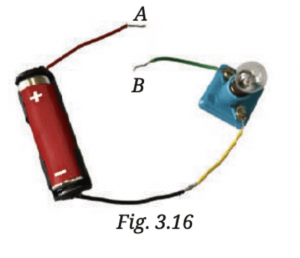
Answer
The lamp will not glow if the material between the ends A and B is an insulator (like rubber, plastic, or wood). These materials do not allow electricity to flow through them.3
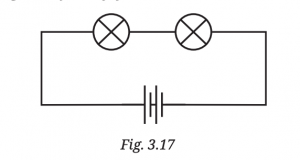
Answer
No, the other lamp will not glow if the filament of one lamp is broken.• If the filament of one lamp breaks, it creates a gap in the circuit.
• This gap means that the path for the electric current is interrupted. When there's a break in the circuit, the current cannot flow through it anymore.
• Even though the other lamp might be perfectly fine, it won't glow because no electricity is reaching it due to the broken connection.
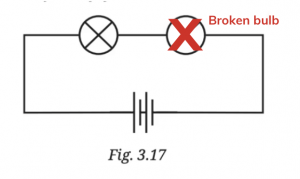
4
Answer
No, the lamp will not glow because the insulator prevents the electric current from passing through the wire, which is necessary for the lamp to glow.To make the circuit work and the lamp glow, you need to remove the insulation from the parts of the wire that connect to the cell and the lamp. This will allow the electricity to flow and make the lamp light up!
5
Answer
A simple torch circuit can be represented as: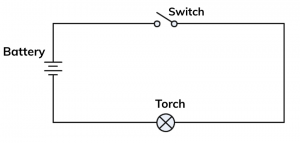
This is a simple series circuit where the battery provides power, the switch controls the current, and the lamp glows when the current flows.
6

(i) If S2 is in ‘ON’ position, S1 is in ‘OFF’ position, which lamp(s) will glow?
(ii) If S2 is in ‘OFF’ position, S1 is in ‘ON’ position, which lamp(s) will glow?
(iii) If S1 and S2 both are in ‘ON’ position, which lamp(s) will glow?
(iv) If both S1 and S2 are in ‘OFF’ position, which lamp(s) will glow?
Answer
(i) Neither lamp will glow because both switch 1 is open.(ii) Neither lamp will glow because both switch 2 is open.
(iii) Both Lamp 1 and Lamp 2 will glow, as both switches are closed, allowing current to flow to both lamps.
(iv) Neither lamp will glow because both switches are open, preventing current flow.
7
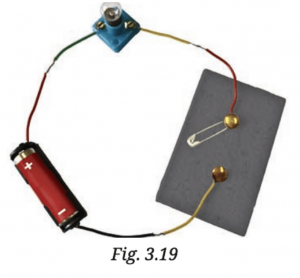
Answer
Possible reasons:
• Broken filament in the lamp (if it's an incandescent lamp).
• Loose connections or poor contact in the circuit.
• Dead battery or improper placement of battery terminals.
• Wires not properly connected to the lamp or battery.
• Open circuit due to a faulty switch or a disconnected part of the circuit.
To find out why the lamp did not glow, one should:
• Check the lamp for a broken filament.
• Ensure all connections are secure.
• Test the battery using a simple tester to ensure it is working.
• Verify that the switch is in the ‘ON’ position.
• Check the wiring to ensure proper electrical contact.
8
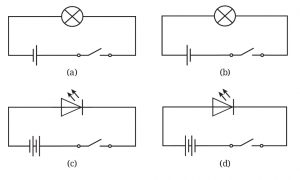
Answer
Case (a), (b), and (d) will glow when switch will be closed but Case (c) will not glow because the negative terminal of the battery is connected to the positive terminal of the LED, meaning the LED is reverse-connected. In this case, no current will flow through the LED, and it will remain off.9
Answer
To check which end of batter is positive and which is negative:
LED Identification: An LED has two leads:
• Longer lead: This is the positive terminal (anode).
• Shorter lead: This is the negative terminal (cathode).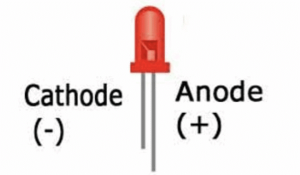
Connect the Battery: Connect the battery's terminals to the LED’s leads:
• Connect the longer lead of the LED to one end of the battery and the shorter lead of the LED to the other end.
Observation:
• The LED will glow only when the longer lead is connected to the positive terminal of the battery and the shorter lead to the negative terminal.
• If the LED doesn't glow, it means the leads are connected in reverse. You can swap the connections to test.
10
Answer
(i) Items required:
• Electric lamp.
• Wires.
• Cell holders.
• Cells A, B, C, D, E, F.
(ii) Procedure:
• Connect each cell one by one in the circuit with the lamp.
• Observe if the lamp glows.
• Record which cells cause the lamp to glow.
(iii) Activity to identify the working cells:
• Test each cell individually in the circuit.
• Mark the cells that cause the lamp to glow as working, and those that don't glow the lamp as non-working.
11
Q11. An LED requires two cells in series to glow. Tanya made the circuit as shown in Fig. 3.21. Will the lamp glow? If not, draw the wires for correct connections.

Answer
No, the LED will not glow if the cells are not connected in the correct polarity. To make the LED glow, the positive terminal of the battery should be connected to the positive terminal of the LED (longer wire), and the negative terminal of the battery should be connected to the negative terminal of the LED (shorter wire).
Corrected connections